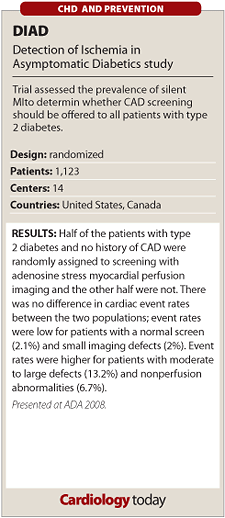DIAD: Favorable five-year outcome for asymptomatic patients with type 2 diabetes and no CAD history
Silent myocardial ischemia in diabetes is not as common as previously thought, according to recent results from the Detection of Ischemia in Asymptomatic Diabetics (DIAD) study.
During the five year study, only 22% of asymptomatic adults with type 2 diabetes experienced silent MI — far lower than expected, according to Frans J. Wackers, MD, PhD, professor emeritus, Yale University School of Medicine.
The researchers recruited 1,123 patients to assess the prevalence of silent MI and discern whether coronary artery disease screening should be offered to all patients with type 2 diabetes. However, based on these data, the researchers said such screening is not justified.
Every individual had at least an eight-year mean duration of diabetes and no history of CAD or cardiac symptoms. Half were randomly assigned to screening with adenosine stress myocardial perfusion imaging. Subsequent diagnostic testing and treatment were performed at the discretion of the patient’s primary physician.

The rate of cardiac events was 0.5% per year and the cumulative cardiac event rate was 2.8%. No difference in cardiac event rates was identified between patients who were screened and those who were not (15 per 558 events vs. 16 per 561 events). Event rates were especially low for patients with a normal myocardial perfusion imaging screen (2.1%) and small myocardial perfusion imaging defects (2%). However, event rates were higher for patients with moderate to large defects (13.2%) and non-perfusion abnormalities (6.7%).
Male sex, peripheral vascular disease, LDL, creatinine and abnormal heart rate response to standing were also predictors of cardiac events. The researchers followed-up at six month intervals and stated that regular follow-up and standard clinical care are sufficient to detect patients at risk for CAD. – by Katie Kalvaitis
For more information:
- Wackers FJ, Young LH, Chyun DA, et al. 169-OR. Presented at: 68th Annual Scientific Sessions of the American Diabetes Associations; June 6-10; San Francisco.
